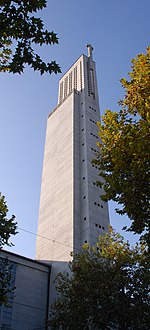Karl Moser: Difference between revisions
some works |
Denisarona (talk | contribs) mNo edit summary |
||
| (41 intermediate revisions by 34 users not shown) | |||
| Line 1: | Line 1: | ||
{{Short description|Swiss architect (1860–1936)}} |
|||
| ⚫ | |||
{{Use dmy dates|date=August 2024}} |
|||
| ⚫ | |||
[[Image:Karlsruhe Christuskirche.jpg|thumb|Christuskirche Karlsruhe]] |
|||
[[Image:ETH-BIB-Moser, Karl (1860-1936)-Portrait-Portr 00350.tif|thumb|Karl Moser]] |
|||
| ⚫ | |||
[[Image:Antoniuskirche Basel.jpg|thumb|150px|Kirche St. Anton in Basel (1927) in the modernist style]] |
|||
Some of their works: |
|||
| ⚫ | |||
* [[Kunsthaus Zurich]] |
* [[Kunsthaus Zurich]] |
||
* [[University of Zurich]] |
* [[University of Zurich]] |
||
* [[Basel Badischer Bahnhof]] |
* [[Basel Badischer Bahnhof]] |
||
* [[St. Paul's Church, Bern]] |
|||
| ⚫ | |||
* St. Anthony's (Antoniuskirche), Basel |
|||
| ⚫ | |||
1915 |
From 1915 to 1928 he was [[professor]] at [[ETH Zurich]]. |
||
In 1928 he was president of the newly founded [[Congrès International d'Architecture Moderne]], an organisation, steered prominently by the pioneers of modernism, architects [[Le Corbusier]] and [[Walter Gropius]], which championed rational and functionalist architecture, while critiquing the type of revivalist architecture typified by Moser's own work. Indeed, it was at this time that Moser's own work changed radically towards modernism, exemplified in the St. Anthony's (Antoniuskirche) in Basel (1925–27), built in reinforced concrete rather than brick and stone typical for his earlier works. |
|||
== Links == |
|||
{{CommonsCat}} |
|||
His son [[Werner M. Moser]] also became a notable architect. |
|||
==References== |
|||
*[[Leonardo Benevolo]]. ''History of Modern Architecture, Volume 2''. MIT Press, 1977 pg. 618 |
|||
{{Commons category}} |
|||
{{Authority control}} |
|||
{{DEFAULTSORT:Moser, Karl}} |
{{DEFAULTSORT:Moser, Karl}} |
||
| Line 19: | Line 32: | ||
[[Category:Swiss architects]] |
[[Category:Swiss architects]] |
||
[[Category:Congrès International d'Architecture Moderne members]] |
[[Category:Congrès International d'Architecture Moderne members]] |
||
[[Category: |
[[Category:ETH Zurich alumni]] |
||
[[Category:Academic staff of ETH Zurich]] |
|||
| ⚫ | |||
| ⚫ | |||
[[de:Karl Moser]] |
|||
[[it:Karl Moser]] |
|||
[[pl:Karl Moser]] |
|||
Latest revision as of 12:52, 10 August 2024
Karl Moser (10 August 1860 – 28 February 1936) was an architect from Switzerland.


Between 1887 and 1915 he worked together with Robert Curjel in Karlsruhe, setting up the architecture firm Curjel and Moser. Some of their works are:
- Kunsthaus Zurich
- University of Zurich
- Basel Badischer Bahnhof
- St. Paul's Church, Bern
- St. Anthony's (Antoniuskirche), Basel
- several Protestant churches
From 1915 to 1928 he was professor at ETH Zurich.
In 1928 he was president of the newly founded Congrès International d'Architecture Moderne, an organisation, steered prominently by the pioneers of modernism, architects Le Corbusier and Walter Gropius, which championed rational and functionalist architecture, while critiquing the type of revivalist architecture typified by Moser's own work. Indeed, it was at this time that Moser's own work changed radically towards modernism, exemplified in the St. Anthony's (Antoniuskirche) in Basel (1925–27), built in reinforced concrete rather than brick and stone typical for his earlier works.
His son Werner M. Moser also became a notable architect.
References
[edit]- Leonardo Benevolo. History of Modern Architecture, Volume 2. MIT Press, 1977 pg. 618